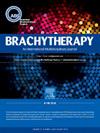前列腺癌患者接受低分次外部放射治疗和单次高剂量率近距离放射治疗后的生化结果。
IF 1.7
4区 医学
Q4 ONCOLOGY
引用次数: 0
摘要
简介:采用体外放射治疗(EBRT)和高剂量率近距离放射治疗(HDR-BT)联合治疗局部高危前列腺癌是一种常见的方法。适度低分次的 EBRT 和单次 HDR-BT 增强治疗简化了治疗过程。我们旨在介绍五年来的研究结果:在这项研究中,我们纳入了 2008 年至 2018 年期间在厄勒布鲁大学医院接受适度低剂量 EBRT(42 Gy,14 次分割)和单次 HDR-BT 增强(14.5 Gy)治疗的 355 名患者。他们定期接受 PSA 检测:组群的中位年龄为70岁(范围:51-81岁),中位随访时间为56个月(范围:6-150个月)。其中,45%被列为极高风险,38%为高风险,17%为中风险。75%的患者接受了中位持续时间为24个月的雄激素剥夺辅助治疗(ADT)。估计的5年无失败生存率分别为79%(全组)、66%(极高危)、90%(高危)和85%(中危)。初始 PSA > 10 ng/mL、Gleason 评分 9-10 和肿瘤分期 T3 与生化失败(BF)显著相关。53例(15%)患者出现PSA反弹,接受ADT治疗的患者的PSA反弹与BF呈反比关系(p = 0.001):结论:适度低分次的EBRT和单次HDR-BT增强似乎是治疗中、高危局部前列腺癌的有效方法。对于复发风险仍然很高的极高危患者,应研究治疗升级策略。本文章由计算机程序翻译,如有差异,请以英文原文为准。
Biochemical outcome of prostate cancer patients treated with hypofractionated external radiation and a single high-dose-rate brachytherapy boost
INTRODUCTION
Treating localized high-risk prostate cancer with a combination of external beam radiation therapy (EBRT) and high-dose-rate brachytherapy (HDR-BT) is a common approach. Moderately hypofractionated EBRT and a single HDR-BT boost simplifies the treatment. We aim to present our five-year results.
METHODS
In this study, 355 patients treated with moderately hypofractionated EBRT (42 Gy in 14 fractions) and a single HDR-BT boost (14.5 Gy) at Örebro University Hospital between 2008 and 2018 were included. They were followed with regular PSA tests.
RESULTS
The median age of the cohort was 70 years (range: 51–81) and the median follow-up duration was 56 months (range: 6–150). Among them, 45% were classified as very high-risk, 38% as high-risk and 17% as intermediate-risk. Adjuvant androgen deprivation therapy (ADT) with a median duration of 24 months was given to 75% of the patient cohort. The estimated 5-year failure free survival rates were 79% (whole cohort), 66% (very high-risk), 90% (high-risk) and 85% (intermediate-risk), respectively. Initial PSA > 10 ng/mL, Gleason score 9–10 and tumor stage T3 were significantly associated with biochemical failure (BF). A PSA bounce occurred in 53 (15%) cases and was inversely associated with BF (p = 0.001) for patients receiving ADT.
CONCLUSIONS
Moderately hypofractionated EBRT and a single HDR-BT boost seems to be an effective treatment against intermediate- and high-risk localized prostate cancer. Treatment escalation strategies should be investigated for very high-risk patients where the risk of recurrence remains high.
求助全文
通过发布文献求助,成功后即可免费获取论文全文。
去求助
来源期刊

Brachytherapy
医学-核医学
CiteScore
3.40
自引率
21.10%
发文量
119
审稿时长
9.1 weeks
期刊介绍:
Brachytherapy is an international and multidisciplinary journal that publishes original peer-reviewed articles and selected reviews on the techniques and clinical applications of interstitial and intracavitary radiation in the management of cancers. Laboratory and experimental research relevant to clinical practice is also included. Related disciplines include medical physics, medical oncology, and radiation oncology and radiology. Brachytherapy publishes technical advances, original articles, reviews, and point/counterpoint on controversial issues. Original articles that address any aspect of brachytherapy are invited. Letters to the Editor-in-Chief are encouraged.
 求助内容:
求助内容: 应助结果提醒方式:
应助结果提醒方式:


